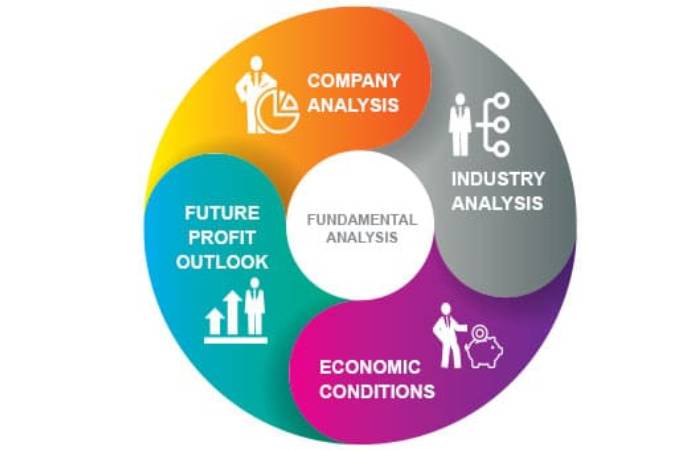Table of Contents
Fundamental Analysis Definition
Fundamental analysis is a method used to assess an asset’s intrinsic value and analyze the issues that could affect its upcoming price.
This type of analysis is founded on evaluating assets based on external events and influences, financial statements, and industrial trends.
It is one of the two main methods used to analyze the market. The other is technical analysis.
While investors who use technical analysis obtain all the information, they need to trade from charts. Those who rely on fundamental analysis look at external factors unrelated to the asset itself’s price movements.
Example of Fundamental Analysis
- Several tools and techniques can use in fundamental analysis, but there are two categories: top-down analysis and bottom-up analysis.
- The top-down analysis offers a broader view of the economy. It begins by analyzing the market as a whole, then focuses on a sector or industry, and finally on a specific company.
- Instead, the bottom-up analysis starts with a specific value and expands to consider all the factors that impact its price.
- Most of the fundamental analysis is used to evaluate the shares’ prices but can use in a diversity of asset classes such as bonds and forex.
- The tools investors can choose for fundamental analysis vary depending on the asset they want to trade with it.
- For example, stock investors can look at the numbers in a company’s earnings reports: earnings, earnings per share (EPS), expected growth, or profit margins.
- However, forex investors may decide to evaluate the figures published by central banks, as they offer an insight into the state of a country’s economy.
Advantages of Fundamental Analysis

- The essential ANALYSIS helps investors to collect adequate information to make rational decisions when determining its position.
- By basing these decisions on financial data, there is little room for personal bias.
- Rather than establishing entry and exit points, the fundamental analysis seeks to understand the value of an asset so that investors can take a longer-term view of the market.
- Once the investor has determined the asset’s numerical value, they can compare it to the current market price to assess whether the investment is overvalued or undervalued.
- The goal is to profit from the market correction.
Disadvantages of Fundamental Analysis
- Fundamental analysis can be time-consuming and involve many research areas, which can make the process too complicated.
- As fundamental analysis offers a much longer-term view of the market, the results are not suitable for making quick decisions.
- Investors who want to create a methodology for short-term investing are better off using technical analysis.
- It is also essential to consider the best and worst-case scenarios. While fundamental analysis offers a multidimensional view of the market, negative legislative, political, and economic changes may surprise markets.
What are the Types of Fundamental Analysis?
The microeconomic and macroeconomic situation affects the economy of the territory and affects the stock market.
Microeconomic variables are those that affect companies, while macroeconomic variables mainly affect States.
It assesses the companies with the most potential. There are different methods based on fundamental analysis. We explain them below:
1. Top-Down Method
An analysis is performed from top to bottom, from the general to the specific. First, a study of the macroeconomic variables carry out, and then the microeconomic variables are studied. We show the following example:
- Study of the global economic situation;
- Study of the most good-looking countries to invest;
- For each country, the sectors with the most potential choose;
- Among the sectors with the most potential, those that offer the most investment opportunities choose.
2. Bottom-Up Method
A bottom-up analysis performs, from the specific to the general. First, a study of the microeconomic variables carry out, and then the macroeconomic variables are studied. We show the following example:
- Study of the companies with the most growth potential.
- The sector or sectors in which these companies operate are analyzed.
- The economic situation of the country or countries in which they operate is studied.
- Finally, the global situation of the economy is analyzed.
Critical Tips from Fundamental Analysis

- Fundamental analysis is a technique of determining the actual or “fair market” value of a stock.
- Fundamental analysts look for stocks that are currently trading higher or lower than their real value.
- If the fair market value advance than the market price, the stock considers undervalued, and a buy recommendation give.
- By contrast, technical analysts ignore the fundamentals in favor of studying historical trends in stock prices.
Understanding Fundamental Analysis
- All equity analysis tries to determine whether a security value correctly within the broader market.
- Fundamental analysis usually does from a macro-to-micro perspective to identify stocks that not value correctly by the market.
- Analysts typically study, in turn, the overall state of the economy and then the strength of the specific industry before focusing on the performance of the individual company to arrive at a fair market value for the title.
- Fundamental analysis uses public data to assess the value of a stock or any other type of security.
- For example, an investor can conduct entire research of the value of a bond by looking at economic issues such as interest rates and the general state of the economy, then
- studying information about the bond issuer, such as possible changes in its credit rating.
- In the case of stocks, the fundamental analysis uses income, earnings, future growth, and return on equity,
- profit margins and other data to control a company’s underlying value and its potential for future growth.
- All of this data is obtainable in a company’s financial statements (more on that below).
Important: Fundamental analysis most often use for stocks, but it is useful for evaluating anything from a bond to a derivative. If you consider the fundamentals, from the general economy to the business’s details, you are doing fundamental analysis.
Investment and Fundamental Analysis
- An analyst works on creating a model to determine the estimated value of a company’s stock price based on publicly available data.
- This value is just an estimate, the analyst’s opinion, of what the company’s stock price should worth compare to the current market price.
- Some analysts may refer to your estimated price as the intrinsic value of the company.
- If an analyst estimates that the stock’s value should be significantly higher than the stock’s current market price, they may post a buy or overweight rating.
- It acts as a recommendation to investors who follow that analyst. If the analyst calculates an intrinsic value lower than the current market price, it considers overvalued and a sell or malnourished recommendation issue.
- Investors who follow these references will expect to buy stocks with reasonable offers because such stocks should be more likely to rise over time.
- Similarly, stocks with unfavorable recommendations expect to have a greater likelihood of falling in price.
- Those stocks are candidates to remove from existing portfolios or added as “short” positions.
- This analysis method considers the opposite of technical analysis, which predicts price direction by analyzing past market information such as price and capacity.
Conclusion
The conclusion obtained with the fundamental analysis is the long-term strategy to increase its value or only for the investor.
It would be to evaluate the opportunity to see if the stock overvalues or overvalued.
Thanking you for the time given to read this blog, we invite you to continue reading what ranking has for you.

